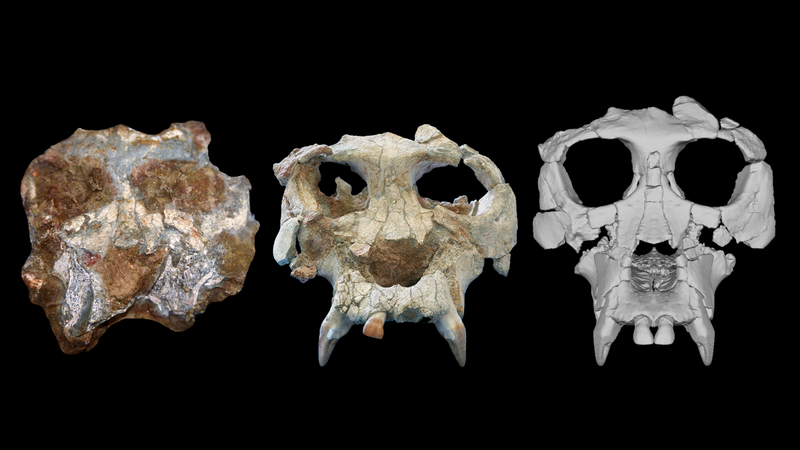Scientists Reconstruct 12-Million-Year-Old Ape Skull

The Pierolapithecus cranium (left), after the fossil’s preparation (center), and its virtual reconstruction (right).
A team of paleoanthropologists has assembled the only known cranium of the extinct ape Pierolapithecus catalaunicus, revealing how the ape’s face looked. The reconstruction allows them to place Pierolapithecus on the hominid family tree and improves our understanding of how the ape moved around Spain some 12 million years ago.
Pierolapithecus was first described in 2004, when a partial skeletal and facial cranium were found in a landfill on the outskirts of Barcelona, Spain. The specimen dated to over 12 million years old and was found alongside two other genera of extinct ape: Dryopithecus and Anoiapithecus. By the original team’s assessment—based on Pierolapithecus’ “primitive monkeylike” characteristics and its skeleton, which indicated the ape could take on an upright posture—the specimen was closely related to the last common ancestor of great apes and humans.
Read more
I Ordered A Carbon-Fiber Roof For My Porsche 996 Turbo And I Might Throw Up A Little
Hawaii Figured Out How To Stop Catalytic Converter Theft, Why Hasn’t Your State?
Will and Jada's Kids Are Reportedly Feeling Very Bad for Dad Right Now
These Are The Ugliest American Cars Ever Made, According To You
“One of the persistent issues in studies of ape and human evolution is that the fossil record is fragmentary, and many specimens are incompletely preserved and distorted,” said study co-author Ashley Hammond, a biological anthropologist at American Museum of Natural History, in a museum release. This makes it difficult to reach a consensus on the evolutionary relationships of key fossil apes that are essential to understanding ape and human evolution.”
The team found that Pierolapithecus’ had similarities with those other great apes extinct and extant, in terms of its general shape and size. Based on evolutionary modeling featuring the newly measured characteristics of the Pierolapithecus cranium, the team determined some facial aspects of last common ancestor of hominids. That ancestor, the team wrote “was distinct in overall shape from all extant and fossil hominids and similar in many features to Pierolapithecus.”
Our last common ancestor remains elusive, but aspects of it are slowly becoming more resolved thanks to newly found fossils and new ways of interrogating previously discovered ones. The newly CT-scanned cranium is allowing scientists to look into the face—almost—of this enigmatic member of our family tree.
More: Humanity’s Origin Story Just Got More Complicated
More from Gizmodo
Final Fantasy VII’s Most Iconic Flashback Is Better Than Ever
Experts Say You Shouldn't Buy These Sports Cars, But They're All Wrong
Sign up for Gizmodo's Newsletter. For the latest news, Facebook, Twitter and Instagram.

